AI EdTech Market Forecasts and Emerging Opportunities in 2025 and Beyond

The global AI EdTech market will reach $5.3 billion in 2025, with forecasts projecting a leap to $98.1 billion by 2034. This surge, driven by a 38.3% CAGR, signals a new ai-powered education era.
Metric | Value |
|---|---|
Global AI in EdTech Market Size (2025) | USD 5.3 billion |
Global AI in EdTech Market Forecast (2034) | USD 98.1 billion |
CAGR (2025-2034) | 38.3% |
US AI in EdTech Market Size (2025) | USD 1.7 billion |
US AI in EdTech Market Forecast (2034) | USD 26.1 billion |
AI guides the digital transformation of education technology worldwide. Edtech companies now see rapid adoption, with 45% planning to use ai-driven analytics. Understanding market size, trends, and opportunities shapes success in the evolving ai ed tech landscape.
Key Takeaways
The AI EdTech market is growing fast, expected to reach $5.3 billion in 2025 and $98.1 billion by 2034, driven by strong adoption worldwide.
Personalized learning, generative AI, and immersive technologies like VR and AR are transforming education by making lessons tailored, engaging, and effective.
North America leads the market, but Asia-Pacific shows the fastest growth due to large student populations and government support.
AI helps teachers by automating tasks, giving students instant feedback, and supporting diverse learning needs, improving outcomes and motivation.
Challenges like data privacy, ethics, and the digital divide require careful attention to ensure AI benefits all students fairly and safely.
Market Size
Current Size
The ai in edtech market has reached a significant milestone in 2024. Multiple research groups estimate the current market size between $4.75 billion and $5.44 billion. The median value stands at $5.065 billion. North America leads the sector, holding a 37% market share and generating $1.6 billion in revenue. This leadership reflects strong investment and early adoption of ai-powered solutions in schools and universities.
Research Group | 2024 Market Size Estimate (USD Billion) | CAGR (%) |
|---|---|---|
IMARC Group | 4.75 | 35.82 |
Grand View Research | 5.09 | 36.0 |
P&S Market Research | 5.44 | 47.2 |
Market.us Report | 5.04 | 35.0 |
The median 2024 market size for ai in edtech market is $5.065 billion, showing strong consensus among leading analysts.
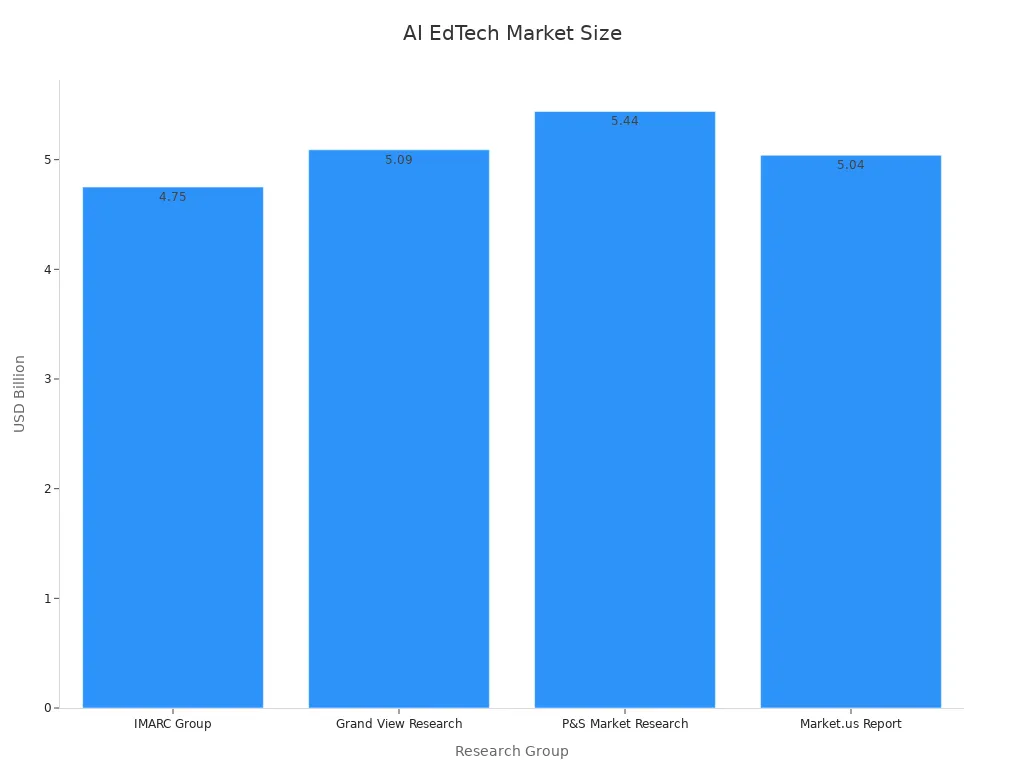
Recent Growth
The edtech market has experienced rapid expansion over the past few years. The global edtech market, which includes ai, is projected to reach $404 billion by 2025. This growth represents more than a 2.5 times increase since 2019. The ai segment stands out with a median compound annual growth rate (CAGR) of 36%. Generative ai in edtech shows even faster growth, with a projected CAGR of 41% from 2024 to 2033.
Metric | Value | Timeframe | Description |
|---|---|---|---|
Compound Annual Growth Rate (CAGR) | 16.3% | 2019-2025 | Growth rate of AI EdTech market post-COVID forecast |
Market Growth Multiple | >2.5x | 2019-2025 | Increase in market size from 2019 to 2025 |
Market Size Projection | $404 billion | 2025 | Global EdTech market size forecast by HolonIQ |
Market Size Increase | $63 billion | Pre-COVID to 2025 | Increase over pre-pandemic forecasts |
Leading Investment Countries | U.S., China, U.K. | N/A | Countries driving AI EdTech investments |
Application Areas | Adaptive learning, administrative systems, student engagement platforms | N/A | Key AI use cases in education |
Generative ai has transformed the sector. In 2023, more than 32% of institutions adopted ai for personalized learning. Over 45% of schools and companies explored ai for administrative tasks. The use of ai in content creation reduced time and cost by 25%. Major edtech companies now integrate ai into their platforms, and over 60% plan to expand these features by the end of 2024.
The recent surge in ai adoption highlights its growing role in shaping the future of education.
Growth Forecast

2025 Projections
The ai in edtech market will see remarkable growth in 2025. Analysts expect the global market to reach $5.3 billion, up from $4.75 billion in 2024. This rapid expansion outpaces the broader edtech sector, which is projected to grow from $215.14 billion in 2024 to $252.45 billion in 2025. The ai segment stands out with a compound annual growth rate (CAGR) of 38.3% from 2025 to 2034, while the overall edtech market grows at a slower pace of about 17.34% through 2033.
The ai in edtech market benefits from strong adoption in K-12 education, where it accounts for 45% of global revenue. Intelligent tutoring systems make up 30% of ai deployments, and natural language processing platforms show 40% year-over-year growth. Asia-Pacific leads with a 32% market share and an annual growth rate of 42%.
Metric / Segment | Projection for 2025 |
|---|---|
Global AI in Education Market Size | Implied increase from USD 6B in 2024 (CAGR 20.11% over 2025-2030) |
Intelligent Tutoring Systems Adoption | 30% of AI education deployments |
Natural Language Processing Platforms | 22% of AI EdTech platforms (40% YoY growth) |
K-12 Sector Revenue Share | 45% of worldwide AI in education earnings |
Asia-Pacific Market Share | 32% of global AI EdTech market |
Asia-Pacific Annual Growth Rate | 42% annual growth |
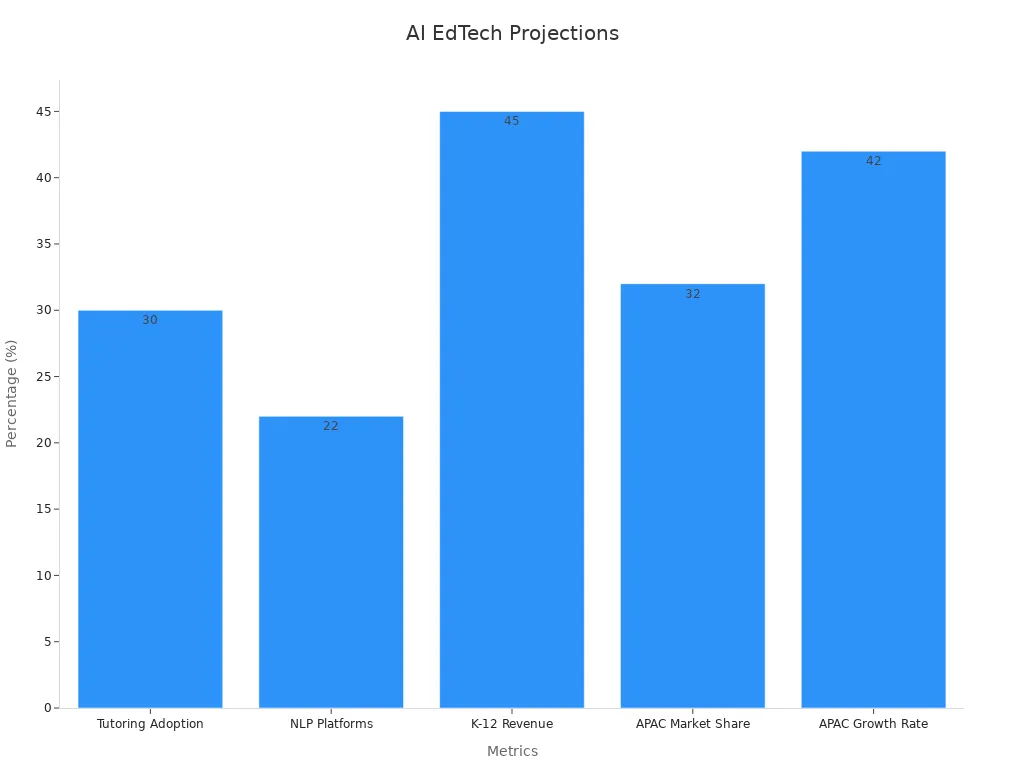
Cloud-based solutions dominate deployment, making up 71.9% of the market in 2025. Corporate training centers emerge as the top end-user, holding 46.6% of the market. Personalized learning remains the leading application, accounting for 42.7% of all ai in edtech market activity.
Metric | Value |
|---|---|
Global Market Size (2034) | USD 98.1 billion |
CAGR (2025–2034) | 38.3% |
Leading Region (2025) | North America (37.2% market share) |
Top Application (2025) | Personalized Learning (42.7%) |
Top Deployment (2025) | Cloud-based solutions (71.9%) |
Top End-User (2025) | Corporate Training Centers (46.6%) |
Long-Term Outlook
The future of ai in edtech market looks even more promising. By 2034, experts predict the market will reach $98.1 billion. This growth forecast reflects the highest CAGR among all edtech segments. Hardware currently holds the largest market share, but software and cloud-based deployments will see the fastest growth rates, with software expected to grow at 15.4% CAGR and cloud solutions at 15.1% CAGR from 2024 to 2032.
Segment | Market Share / CAGR Details |
|---|---|
Hardware (2022) | Highest market share (>50%) |
Software | Highest CAGR 15.4% (2024-2032) |
Deployment On-premise | Highest market share (~33%) |
Deployment Cloud | Highest CAGR 15.1% (2024-2032) |
Sector K-12 | Highest market share (~40%) |
Sector Preschool | Highest CAGR 16.3% (2024-2032) |
End User Business | Highest market share (~40%) |
End User Consumer | Highest CAGR 15.0% (2023-2032) |
Region Asia-Pacific | Highest revenue share (~75%) (2022) |
The ai in edtech market will benefit from several long-term trends:
Governments will increase ai education policy initiatives by up to 180% in the next five years.
More countries will adopt evidence-based funding models, using return-on-investment calculations to guide spending.
Curriculum reforms will expand, with 28 countries reviewing standards and 13 implementing ai literacy.
Teacher development will improve, as ai-assisted training raises instructional quality by 41%.
Accessibility will advance, with a 418% growth in ai-powered resources and 73% meeting accessibility standards.
Hybrid intelligence systems, which combine human and ai strengths, will show a 43% effectiveness advantage over traditional methods.
International collaboration will rise, with an 87% increase in cross-border education data sharing.
Policymakers will focus on ethical ai, with 78% prioritizing fairness and transparency.
These trends will drive the ai in edtech market to new heights, making ai a central force in the future of education.
The broader edtech market will also grow, but at a slower rate. Reports show a CAGR of about 20.83% for the overall sector from 2024 to 2033. AI will remain the key driver of innovation, powering adaptive learning, chatbots, and advanced analytics. As a result, the ai in edtech market will continue to outpace the rest of the industry.
Key Trends
Personalized Learning
Personalized learning stands at the forefront of ai ed tech innovation. Schools and companies use ai in edtech to tailor lessons to each student’s strengths and needs. AI technologies like TensorFlow Lite and TinyML enable low-latency, on-device machine learning. These tools help deliver real-time feedback and adaptive content. Many edtech startups now focus on personalized learning solutions, driving rapid product development. Research shows that ai-driven personalised learning systems can improve academic performance by up to 30%. For example, Squirrel AI in China and Carnegie Learning in the U.S. have reported significant gains in math scores. Students in these programs improved by 8 percentile points in math and 9 in reading within a year. Schools also saw a 12% increase in attendance and a 15% drop in dropout rates. Student engagement rose, with 75% feeling more motivated compared to 30% in traditional classrooms. Over three years, graduation rates increased by 25%. These results highlight the impact of artificial intelligence in education technology on student success.
Generative AI
Generative AI is transforming the ai ed tech landscape. It creates new ways for students and teachers to interact with content. This technology enables personalized learning experiences and supports academic writing and research. Microsoft’s AI in Education Report shows that educators use generative AI to lighten workloads and boost productivity. Many teachers and students now rely on ai-powered tutors and automated grading systems. These tools help improve learning outcomes and operational efficiency. Institutions like Cornell University have developed flexible policies to balance the benefits of generative AI with ethical concerns. The LiDA community offers resources and training modules to guide responsible use. Generative AI also fosters creativity and supports academic investigations, making it a key driver in artificial intelligence in education technology.
VR and AR
Virtual reality (VR) and augmented reality (AR) play a growing role in ai in edtech. These immersive technologies enhance collaborative skills, empathy, and experiential learning. Medical and healthcare training programs use VR and AR simulations for risk-free practice. Engineering and architecture students benefit from mixed reality applications that help them understand complex concepts. Immersive learning environments create virtual labs, simulated ecosystems, and global market explorations. These experiences boost student motivation and engagement. In vocational training, VR and AR improve practical skill acquisition and employability. However, challenges remain, such as cost, infrastructure, and faculty training. Despite these barriers, VR and AR continue to enrich online and remote education.
Learning Analytics
Learning analytics drive continuous improvement in ai ed tech. The market for learning analytics is expected to reach $14.3 billion by 2026. Schools use software solutions and prescriptive analytics to recommend precise educational interventions. Predictive analytics identify at-risk students early, enabling timely support. Educators use data-driven insights to tailor instruction and close achievement gaps. For example, Arizona State University’s eAdvisor system uses over 800 data points to trigger interventions, resulting in a 33% increase in retention and a 50% reduction in achievement gaps. Learning analytics also increase student engagement, with a 3.2x rise in help-seeking behavior and a 56% boost in student-content interactions. These tools support mastery-based progression and gamified learning experiences, making ai in edtech more effective and equitable.
Drivers and Opportunities

Regional Growth
Regional growth in the AI EdTech market shows strong momentum across the globe. North America leads with over 38% of the global share, driven by high digital literacy and widespread adoption of AI tools in both K-12 and corporate training environments. Europe follows, supported by government funding and digital programs in countries like Germany and the UK. Asia-Pacific stands out as the fastest-growing region, fueled by a large student base, mobile platform access, and government support in China, India, and Japan. The Middle East and Africa are emerging markets, with universities and schools rapidly adopting cloud-based solutions and online learning.
Region | Market Share / Growth Indicator | Key Drivers and Opportunities |
|---|---|---|
North America | Dominates with over 38% global share | High digital literacy, 79% schools with LMS, 72% K-12 digital classrooms, 61% corporate EdTech growth, 65% AI tool adoption |
Europe | Around 18% of global market | Government funding, 66% institutions use e-learning, 59% mobile learning apps, 54% EU nations with digital programs |
Asia-Pacific | Over 32% of global market, fastest-growing | Large student base, 74% mobile platform access, 68% urban schools with smart classes, 62% e-learning enrollment increase |
Middle East & Africa | Approximately 12% of global market | 61% universities offer online learning, 49% mobile learning adoption in Sub-Saharan Africa, 55% schools with cloud solutions |
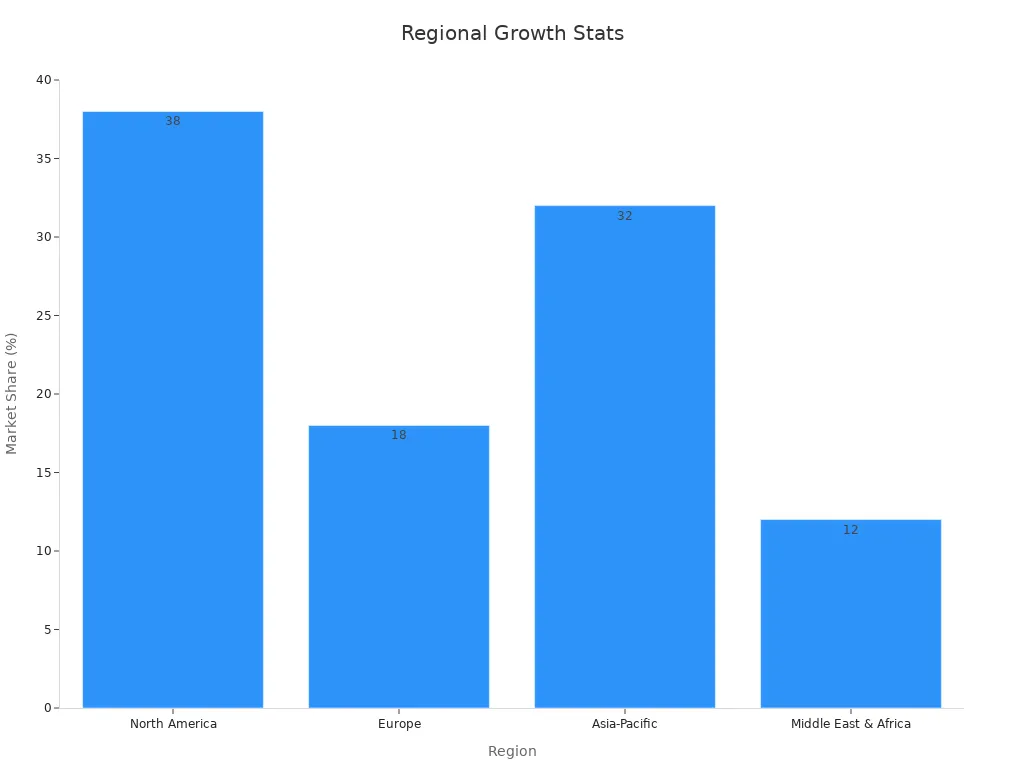
These trends highlight opportunities for AI-powered personalized learning and cloud-based corporate training solutions worldwide.
New Applications
AI continues to drive innovation in EdTech through new applications that support both students and educators. Adaptive learning platforms personalize instruction based on real-time performance. Assistive technologies, such as speech recognition, help students with disabilities. Learning analytics give teachers actionable insights for tailored instruction. AI-powered classroom management tools gamify engagement and track behavior. Automated grading and assessment tools streamline feedback. Chatbots and virtual assistants provide 24/7 student support. AI also helps with curriculum planning and exam security. Language learning platforms use AI to adjust difficulty and personalize lessons. Virtual 3D classrooms and immersive environments expand interactive learning.
AI-driven adaptive learning platforms personalize instruction.
Assistive technologies support students with disabilities.
Learning analytics provide actionable insights for educators.
AI-powered classroom management tools gamify engagement.
Automated grading tools streamline evaluation.
Chatbots and virtual assistants offer 24/7 support.
AI aids curriculum planning and proctoring.
Language learning platforms adapt difficulty.
Virtual 3D classrooms expand interactive learning.
Experts see AI as a key enabler for personalized education, improved accessibility, and enhanced corporate training.
Investment Trends
Recent financial reports show a surge in investment in the AI EdTech sector. Global EdTech funding reached $16.3 billion in 2018, up from $9.6 billion in 2017. China captured 44.1% of global funding, surpassing the US at 32%. Latin America also attracted over $450 million in online learning investments. This shift reflects growing confidence in AI and technology's role in digital transformation and education.
Metric | Q1 2025 Value | Change vs Previous Year |
|---|---|---|
Revenue | +142% | |
Net Loss | $171,434 | -43% |
Loss before non-cash adj | $158,323 | -64% |
2024 Full-year Net Profit | $358,794 | From $40,573 loss in 2023 |
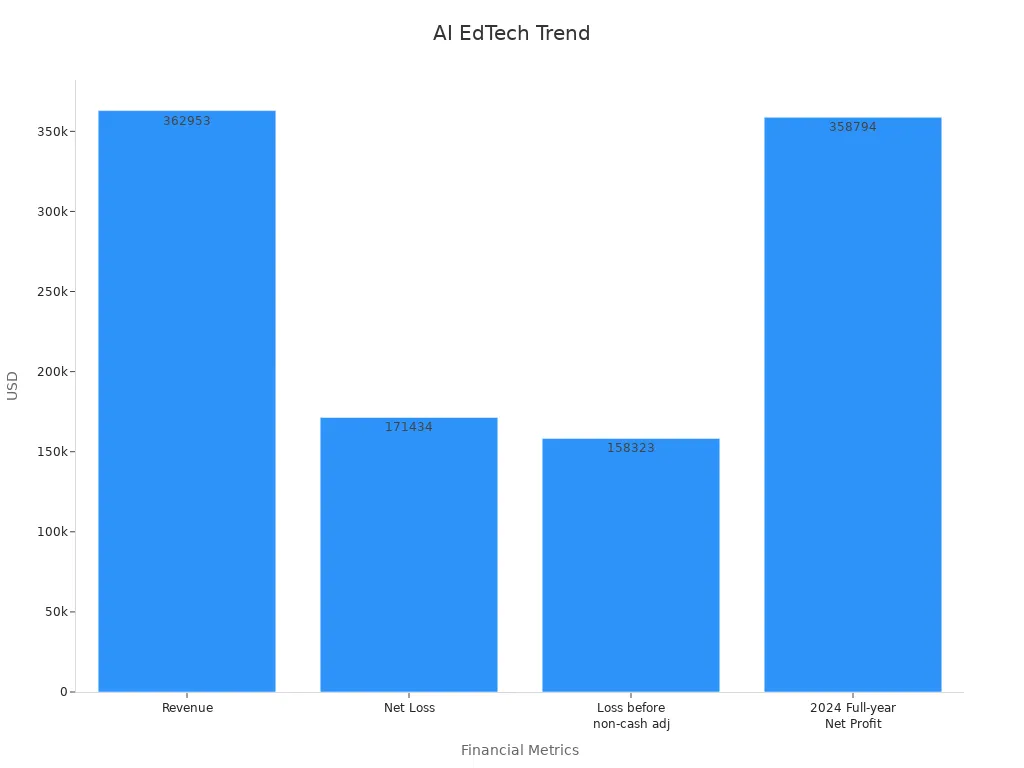
EdTech venture funding increased by 45%, supporting AI-driven tutoring and gamified platforms.
Investment in cloud-based education platforms rose by 50%, enabling remote learning and automated grading.
Funding for STEM-focused AI solutions grew by 35%, emphasizing robotics and coding education.
Global partnerships between tech firms and educational institutions expanded by 40%, enhancing access to digital education tools.
The rise in investment supports rapid growth in AI-powered EdTech, especially in corporate training and global markets.
Challenges
Data Privacy
AI EdTech platforms collect and process large amounts of student data. This creates several privacy concerns for schools and families. AI systems often reuse training data for new purposes, which can reduce transparency and make it hard for individuals to know how their information is used. The need for large datasets conflicts with the principle of collecting only what is necessary, especially as schools face frequent cyberattacks—over 2,500 per week in early 2024. Ensuring data accuracy is difficult, since students may not have a way to correct AI-generated errors. While AI can support diversity, it may also reinforce biases if the training data is not balanced. Edge AI, which processes data on local devices, helps protect privacy by reducing the risk of breaches. However, this approach faces hardware limitations, especially in low-cost devices. Universities like Arizona State are developing secure learning platforms that do not share raw data, improving privacy. Collaboration between technology companies and EdTech providers is leading to open-source frameworks that support privacy regulations such as GDPR and FERPA.
Ethics
Ethical challenges in AI EdTech affect students, teachers, and institutions. Automated grading systems can introduce bias, as seen in England when an AI algorithm for exam scores unfairly impacted students from underrepresented groups. AI tools sometimes share sensitive information, like racial identity or location, without proper consent. Surveillance features in AI platforms can track student actions, which may limit their freedom and privacy. Bias in AI models, such as gendered translations or facial recognition errors, can lead to discrimination. Predictive AI systems may also restrict the ability of students and teachers to make independent choices. Some educational programs, like the MIT Media Lab’s curriculum, now teach students about these ethical risks to help them understand and address such issues.
Digital Divide
Access to AI EdTech remains unequal across different communities. Over 28% of children in the United States do not use the internet at school or home. Students from lower-income families and those living in rural areas often lack reliable internet, modern devices, and updated software. The COVID-19 pandemic made these gaps more visible, as remote learning became essential. Infrastructure differences between urban and rural areas limit access to electricity and broadband. Affordability issues prevent many families from buying devices or paying for internet service. Digital literacy gaps, language barriers, and lack of training further widen the divide. Marginalized groups, including those affected by race, gender, disability, or location, face even greater challenges. Without targeted investment in infrastructure and inclusive AI design, these inequalities may grow, making it harder for all students to benefit from AI-powered education.
Impact
Educators
AI in edtech changes how teachers work. Many educators now use AI tools to automate grading, plan lessons, and manage classrooms. A 2020 McKinsey report shows that AI can automate up to 40% of teachers’ tasks. This shift allows teachers to spend more time with students and less on paperwork. The HMH Educator Confidence Report notes that 82% of teachers see workload balance as critical. AI helps reduce burnout by streamlining daily routines. Experts like Francie Alexander highlight four main benefits: higher productivity, better social connections, improved data use, and more instructional support. Teachers who use a structured approach—such as keeping an AI teaching journal—see steady improvements in efficiency. However, some risks remain. Teachers must learn new tools and adapt to changing roles, which can be stressful.
Students
Students benefit from personalized learning powered by artificial intelligence in education technology. AI tailors lessons to each student’s needs, giving instant feedback and making learning more engaging. Research from the Review of Educational Research finds that AI-enhanced personalized learning can improve student outcomes by up to 20%. Some studies show a 30% improvement in performance. Students gain deeper understanding, better critical thinking, and more ownership of their learning. AI also helps students with disabilities by making content more accessible. Still, not all students have equal access to these tools, which can widen the digital divide.
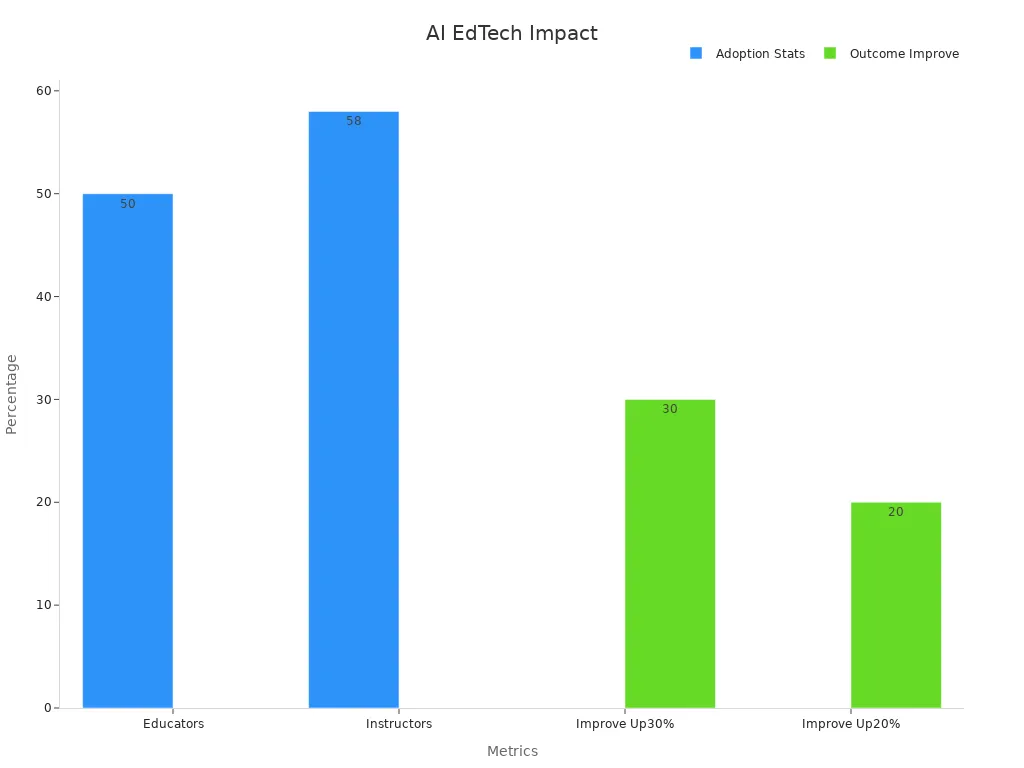
Companies
Edtech companies see strong gains from AI integration. Platforms like Duolingo use AI to create adaptive lessons and real-time feedback, boosting engagement and results. Google Classroom uses AI to manage assignments and feedback, saving time for teachers. Companies also use AI to analyze data, improve courses, and spot students who need help early. These advances help companies meet diverse student needs and improve academic results. However, companies must address privacy, bias, and ethical concerns as they expand AI use.
Investors
Investors view the ai in edtech market as a high-growth opportunity. The market size reached $3.65 billion in 2023 and could grow to $92.09 billion by 2033, with a CAGR of 38.1%. Key segments include cloud platforms, personalized learning, and corporate training. North America leads the market, but Asia-Pacific shows rapid growth. Major players like Google, Microsoft, and Duolingo drive innovation. Investors must watch for risks such as regulatory changes and market competition, but the potential for strong returns remains high.
Future Outlook
Market Evolution
The future outlook for AI in EdTech points to rapid transformation and expansion. Analysts project the market will grow by over $170 billion between 2025 and 2029. AI will drive this growth by enabling personalized learning at scale, where adaptive platforms and real-time analytics tailor lessons to each student. The integration of AI teaching assistants, immersive AR/VR environments, and automated assessments will reshape classrooms and online learning. AI will also bridge education and workforce development, offering predictive career guidance and virtual apprenticeships. The shift to digital content, cloud deployment, and advanced hardware like interactive displays will further accelerate adoption. Despite ongoing challenges such as the digital divide and data privacy, strong venture capital investment and a focus on measurable educational impact signal a dynamic future for the sector.
AI will continue to transform education by making learning more accessible, inclusive, and effective for diverse learners worldwide.
Key areas of evolution include:
Personalized learning environments that adapt in real time.
AI-powered workforce development tools.
Virtual teaching assistants and automated lesson planning.
Inclusive solutions for students with disabilities.
Immersive AR/VR learning experiences.
Data-driven decision support for educators and institutions.
Strategic Recommendations
Stakeholders can position themselves for success in the evolving AI EdTech landscape by following several strategic steps:
Utilize cloud computing for flexible and scalable infrastructure.
Employ data analytics to personalize learning and guide decisions.
Implement AI and machine learning to automate processes and deliver tailored education.
Build robust IT systems to support growth and integration.
Automate routine tasks to increase efficiency and free up educators for creative work.
Design modular products that adapt to different markets and needs.
Continuously improve offerings based on user feedback and emerging trends.
Prioritize data security and compliance with regulations like GDPR and FERPA.
Localize platforms for global reach and diverse learners.
Foster a data-driven culture to support ongoing adaptation and improvement.
Institutions that define clear objectives, invest in the right tools, and build strong partnerships will lead the next wave of AI-powered education.
The AI EdTech market will grow rapidly, with projections reaching $600 billion by 2033. Key trends include personalized learning, generative AI, and immersive AR/VR experiences.
North America and Europe lead due to strong technology infrastructure.
Asia-Pacific shows exponential growth, especially in India and China.
Corporate upskilling and blended learning models drive expansion.
Educators, companies, and investors should focus on adaptive platforms, invest in digital skills, and support inclusive access to maximize future opportunities.
FAQ
What is AI EdTech?
AI EdTech uses artificial intelligence to improve learning and teaching. These tools help teachers personalize lessons, automate grading, and support students with instant feedback. AI EdTech platforms also analyze data to find learning gaps and suggest improvements.
How does AI personalize learning for students?
AI systems track student progress and adjust lessons based on strengths and weaknesses. These platforms recommend activities, quizzes, or videos that match each learner’s needs. Students receive real-time feedback, which helps them stay motivated and improve faster.
Are there risks with using AI in education?
Data privacy and bias present major risks. Schools must protect student information and ensure AI tools treat everyone fairly. Teachers and parents should review how platforms use data and check for transparency in AI decision-making.
Which skills will students need for the future AI-powered classroom?
Students will need digital literacy, problem-solving, and adaptability. They should learn to use technology responsibly and understand basic AI concepts. Collaboration and communication skills will also help them succeed in classrooms that use AI tools.
See Also
Explore Top 10 Cutting-Edge AI App Creators 2025
Learn Ways To Profit From AI Technology In 2025
12 Strategies To Integrate AI Into SaaS Products 2025

